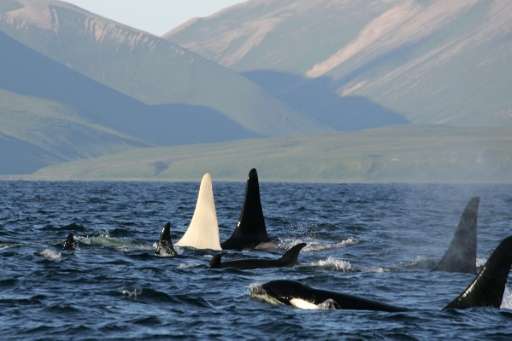Toxic chemicals known by the acronym PCBs are poisoning killer whales in European waters, and in some cases severely impeding their ability to reproduce, researchers reported
Killer whales in European waters face extinction due to outlawed but long-lived pollutants that also threaten several species of dolphins, according a study released Thursday.
Toxic chemicals known by the acronym PCBs are poisoning these marine mammals, and in some cases severely impeding their ability to reproduce, researchers reported.
Becoming more concentrated as they move up the food chain, PCBs settle into the fatty tissue of top ocean predators.
The deadly compounds—used in manufacturing and construction and banned across the European Union in 1987—can also be passed on to orca and dolphin calves suckling their mothers' milk.
"Few coastal orca populations remain in western European waters," said lead author Paul Jepson of the Zoological Society of London, noting that those in the Mediterranean and North Sea have already disappeared.
"The ones that do persist are very small and suffering low or zero rates of reproduction."
A community of 36 orcas, or killer whales, off the coast of Portugal—observed by scientists for decades—has not produced any offspring in more than ten years, the study reported.
An even smaller grouping near Scotland "will go extinct," Jepson told journalists by phone.
The death of a female known as Lulu, whose carcass was discovered on the Scottish island of Tiree last week, reduced this pod from nine to eight.
As well as direct observation, biopsies of individuals in the wild have also shown that these orca populations are not reproducing.
When female killer whales give birth, they transfer about 90 percent of the PCBs accumulated in their bodies—sometimes over decades—to their calves, purging themselves but poisoning their offspring.
Recent biopsies, however, revealed that all the females have the same level of PCB toxins in their system as males, evidence that they had not produced calves in the preceding years.
The toxic effect of PCBs on marine mammals was known, but this is the first overview—based on tissue samples from more than 1,000 stranded and biopsied whales, dolphins and orcas—of the extent of the damage.
Climbing the food chain
PCBs were widely used in manufacturing electrical equipment, paints and flame retardants. Designed to withstand weathering, they were also added to sealants used in buildings.
Europe produced some 300,000 tonnes of the compound from 1954 to 1984, and 90 percent of it has yet to be destroyed or safely stored away.
PCBs—which do not dissolve in water—reach the ocean via several routes.
"It is leaching from landfills into rivers and estuaries, and eventually into the marine environment," Jepson explained.
Sediment dredging to a depth of ten metres (30 feet) along shipping lanes in industrial ports brings the deadly chemicals to the surface.
From there, they gradually climb the food chain, becoming more toxic along the way: from bottom-feeding mollusks to crabs to small fish to the bigger fish eaten by orcas, dolphins and porpoises.
Further north, a healthier population of several thousand orcas living in waters near Iceland and northern Norway provide additional evidence that PCBs are, in fact, causing the decline of their cousins to the south.
Whereas the southern killer whales eat large fish and mammals, such as seals, the Arctic orcas subsist almost exclusively on herring.
Because herring eat plankton, they are outside the food chain along which PCBs climb, explaining why the northern orcas have ten times less PCB in their fatty tissue.
Disposing of land-based PCBs—made to resist heat, chemical attack and degradation—is difficult, Jepson said.
"They were designed to last a very long time, so it is incredibly hard to destroy them."
© 2016 AFP























